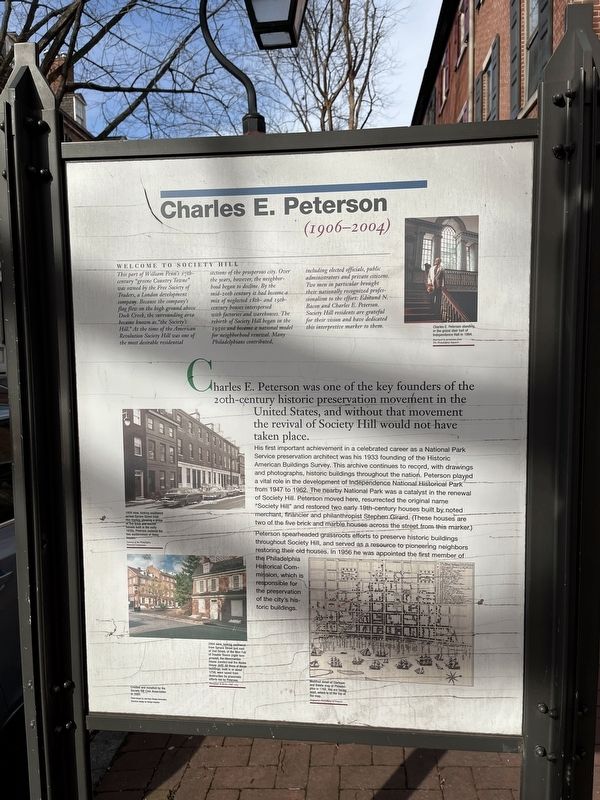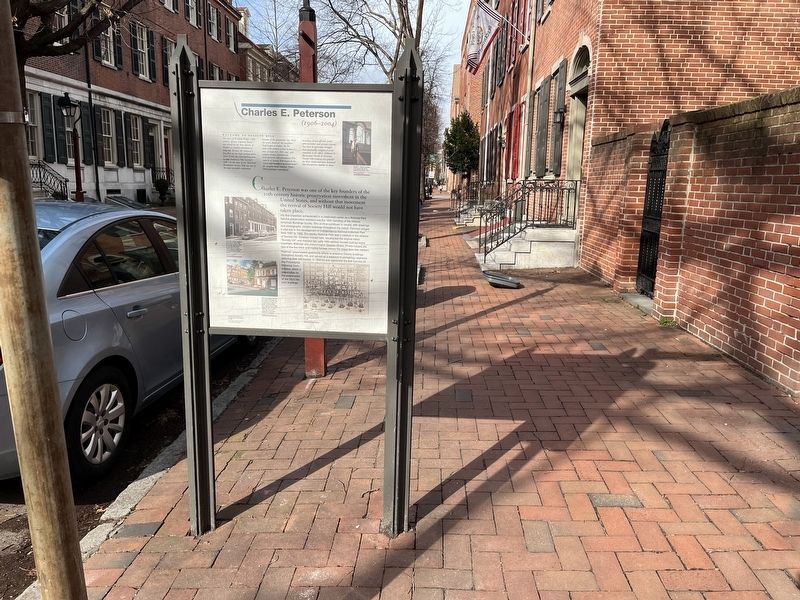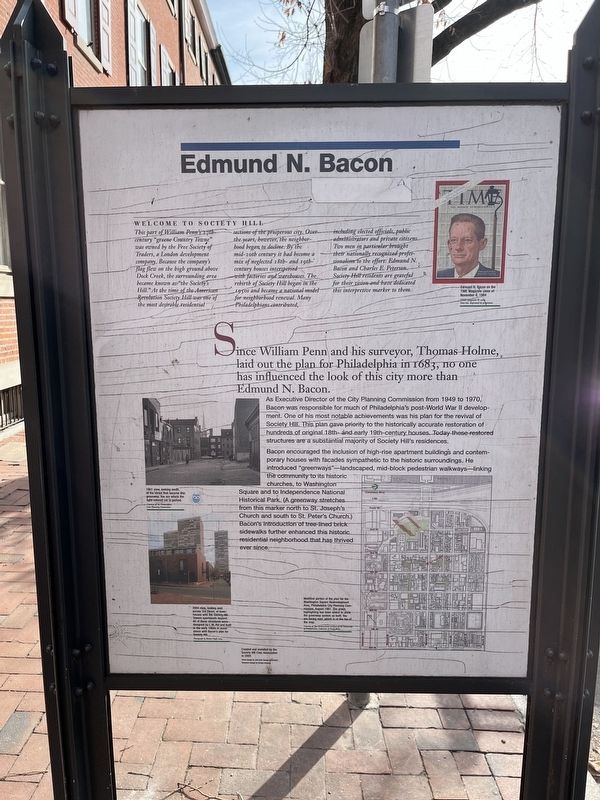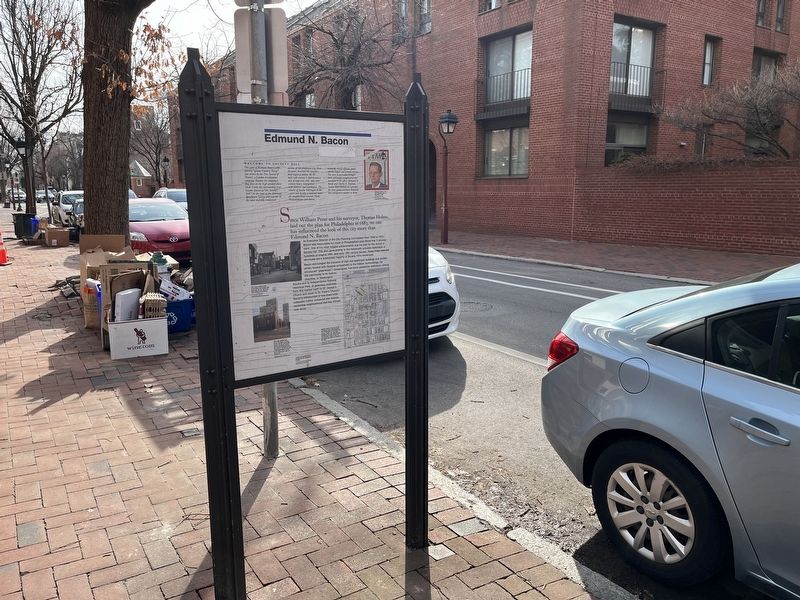Society Hill in Philadelphia in Philadelphia County, Pennsylvania — The American Northeast (Mid-Atlantic)
Charles E. Peterson (1906 - 2004) / Edmund N. Bacon

Photographed By Devry Becker Jones (CC0), February 26, 2022
1. Charles E. Peterson (1906 - 2004) side of the marker
Welcome to Society Hill
This part of William Penn's 17th-century "green Country Towne" was owned by the Free Society of Traders, a London development company. Because the company's flag flew on the high ground above Dock Creek, the surrounding area became known as "the Society's Hill." At the time of the American Revolution Society Hill was one of the most desirable residential sections of the prosperous city. Over the years, however, the neighborhood began to decline. By the mid-20th century it had become a mix of neglected 18th- and 19th-century houses interspersed with factories and warehouses. the rebirth of Society Hill began in the 1950s and became a national model for neighborhood renewal. Many Philadelphians contributed including elected officials, public administrators and private citizens. Two men in particular brought their nationally recognized professionalism to the effort: Edmund N. Bacon and Charles E. Peterson. Society Hill residents are grateful for their vision and have dedicated this interpretive marker to them.
Charles E. Peterson
(1906 - 2004)
Charles E. Peterson was one of the key founders of the 20th-century historic preservation movement in the United States, and without that movement the revival of Society Hill would not have taken place.
His first important achievement in a celebrated career as a National Park Service preservation architect was his 1933 founding of the Historic American Buildings Survey. This archive continues to record, with drawings and photographs, historic buildings throughout the nation. Peterson played a vital role in the development of Independence National Historical Park from 1947 to 1962. The nearby National Park was a catalyst in the renewal of Society Hill. Peterson moved here, resurrected the original name "Society Hill" and restored two early 19th-century houses built by noted merchant, financier and philanthropist Stephen Girard. (These houses are two of the five brick and marble houses across the street from this marker.)
Peterson spearheaded grassroots efforts to preserve historic buildings throughout Society Hill, and served as a resource to pioneering neighbors restoring their old houses. In 1956 he was appointed the first member of the Philadelphia Historical Commission, which is responsible for the preservation of the city's historic buildings.
[Captions:]
Charles E. Peterson standing in the grand stair hall of Independence Hall in 1954.
1959 view, looking southwest across Spruce Street from this marker, showing a group of live brick and marble

Photographed By Devry Becker Jones (CC0), February 26, 2022
2. Charles E. Peterson (1906 - 2004) side of the marker
2004 view, looking northwest from Spruce Street just east of 2nd Street, of the Man Full of Trouble Tavern (right foreground), the Abercrombie House (center) and the Neave House (left). All three of these buildings, built in or about 1759 were saved from destruction by grassroots efforts led by Peterson.
Modified detail of Clarkson and Biddle map of Philadelphia in 1762. You are facing west, which is at the top of the map.
Edmund N. Bacon
Since William Penn and his surveyor, Thomas Holme laid out the plan for Philadelphia in 1683, no one has influenced the look of this city more than Edmund N. Bacon.
As Executive Director of the City Planning Commission from 1949 to 1970, Bacon was responsible for much of Philadelphia's post-World War II development. One of his most notable achievements was his plan for the revival of Society Hill. This plan gave priority to the historically accurate restoration of hundreds of original 18th- and early 19th-century houses. Today these restored structures are a substantial majority of Society Hill's residences.
Bacon encouraged the inclusion of high-rise apartment buildings and contemporary houses with facades sympathetic to the historic surroundings. He
[Captions:]
Edmund N. Bacon on the cover of Time Magazine cover of November 6, 1964
1961 view, looking south, of the street that became this greenway. You are where the light-colored car is parked.
2004 view, looking east across 3rd Street, of townhouses with the Society Hill Towers apartments beyond. All of these structures were designed by I.M. Pei and built in the early 1960s in accordance with Bacon's plan for Society Hill.
Modified portion of the plan for the Washington Square Redevelopment Area, Philadelphia City Planning Commission, August 1961. The green highlighting has been added to show the greenway system as built. You are facing east, which is at the top of the map.
Erected 2005 by Society Hill Civic Association.
Topics. This historical marker is listed in these topic lists: Architecture
Location. 39° 56.694′ N, 75° 8.863′ W. Marker is in Philadelphia, Pennsylvania, in Philadelphia County. It is in Society Hill. Marker is at the intersection of Spruce Street and St. Josephs Way, on the right when traveling west on Spruce Street. Touch for map. Marker is at or near this postal address: 319 Spruce St, Philadelphia PA 19106, United States of America. Touch for directions.
Other nearby markers. At least 8 other markers are within walking distance of this marker. Physick House (about 300 feet away, measured in a direct line); Philip Syng Physick (about 300 feet away); Old St. Mary’s Roman Catholic Church (about 300 feet away); Barry (about 300 feet away); Old St. Mary Cemetery (about 400 feet away); Old St. Mary's (about 400 feet away); Manuel Torres (about 400 feet away); “The Place You Tread is Holy Ground-” (about 400 feet away). Touch for a list and map of all markers in Philadelphia.
Additional keywords. Charles E. Peterson (1906 - 2004) / Edmund N. Bacon
Credits. This page was last revised on February 2, 2023. It was originally submitted on March 2, 2022, by Devry Becker Jones of Washington, District of Columbia. This page has been viewed 111 times since then and 23 times this year. Photos: 1, 2, 3, 4. submitted on March 2, 2022, by Devry Becker Jones of Washington, District of Columbia.

